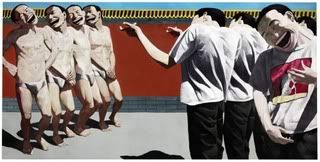Jacques Attali- Noise: The Political Economy of Music
Music and politics mix on an illicit frequency. Listener C is a crafty, educated political listener. What concerns her, unlike her disconnected friends A and B, is each track's background noise, its sonic subtext that echoes other systems, structures, functions and types of wiring.
Our musical systems and structures aren't Cagey, formalist or theoretical but they do predetermine certain things. First we remember the capitalist system (and of course, its encoded structure), which creates a strict hierarchy of commodities, exposure and style. It's a monetary system. Every time C, the political listener, hears anything, she's aware of this system, how it determines the shape of the band, the recording studio and the end product.
Each band is structured around an outdated model where the Voice is allowed tremendous power and the remaining sounds are nearly muted. The producer who foregrounds the Voice writes a sonic synecdoche of government, allowing a single person prominence over all others, at their expense, while they silently work within like civil servants. There are echoes of political structure again as patterns of behaviour are enforced. Research indicates particular qualities within the Voice that need to be tapped, amplified and looped. Certain behaviour must be avoided, a selling point (a capitalist necessity) must be located for successful continuation of the product and it must be endorsed by past candidates to achieve the correct level of exposure. The contours of capitalism can grafted onto the artistic process without a slight hiccough.
It's alright cos the historical pattern has shown
How the economical cycle tends to revolve [...]
Bigger slump and bigger wars and a smaller recovery.
Stereolab, Ping Pong
The product's function isn't clear. C knows the intention is to plug a void, to provide a Voice for the Voiceless, but usually there are the sensations of multi-tracking, of sampling, looping, performing cover versions. C knows these Voices are familiar, have been heard before, and are only slightly different from their ancestors... perhaps the pitch's shifted a little but who can say? Wiring is the shadowiest element of all. The wires in machines are invisible: they run power back and forth, they maintain power and they lurk behind, within, the other systems and structures. C knows that corporations own the wiring, they control how the machine operates: all wiring leads to a singular power source. But political listening doesn't create transparency. We know that awareness of the machine's deficiencies (solidity in an age of steam) doesn't speed its collapse.
Political listening is a kind of violence. The political listener, our beautiful C, isn't a participant in mass culture and its fake images of togetherness. She knows listening is political, ethical, an act of disquiet. It means attack, escape and rejection. The substance of political music isn't always superficial. The audio-incendiary noise of Rage Against The Machine is, yeah, political but it doesn't represent a disengagement from conventional politics or any alternatives other than the stratified, straitjacketing microcosm of 'alternative' invented by the market place. The political act lies with the listener. It's the heavy-puffing Christian Slater of Pump Up The Volume, secretly transmitting in his bedroom, who can fuck things up, mangle the system and start fires in the miserable Reagan '80s. And perhaps Eisenstein's collaboration with Prokofiev, with its scarcely-hidden attack on Stalin's terror, via his love of musicals, is a great political act, one where all the wiring is viciously made visible.
The political listener takes the noise, the reverberations, the desolation of contemporary sound and reforms them as a violent act or thought. Once the standards and stereotypes are rejected by the individual then she can speak for herself and her listening become political.
Untitled piece by Hermann Nitsch. No copyright infringement intended.

















